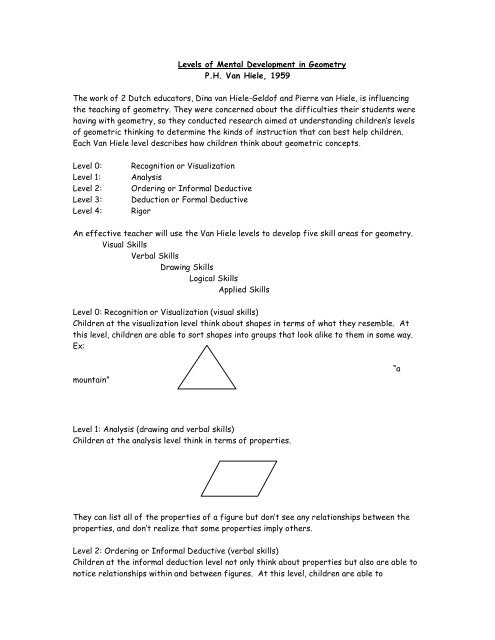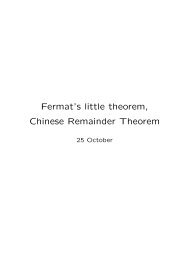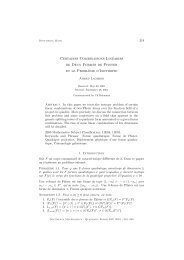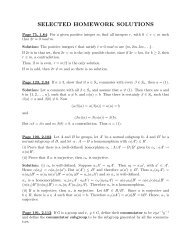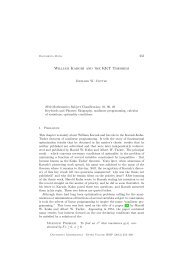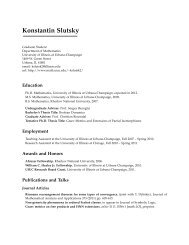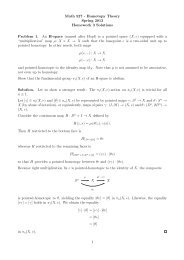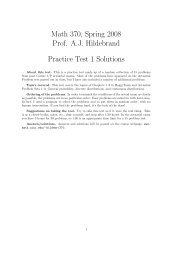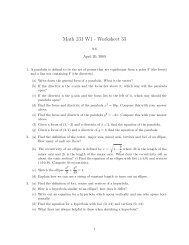Levels of Mental Development in Geometry P.H. Van Hiele, 1959 ...
Levels of Mental Development in Geometry P.H. Van Hiele, 1959 ...
Levels of Mental Development in Geometry P.H. Van Hiele, 1959 ...
You also want an ePaper? Increase the reach of your titles
YUMPU automatically turns print PDFs into web optimized ePapers that Google loves.
<strong>Levels</strong> <strong>of</strong> <strong>Mental</strong> <strong>Development</strong> <strong>in</strong> <strong>Geometry</strong><br />
P.H. <strong>Van</strong> <strong>Hiele</strong>, <strong>1959</strong><br />
The work <strong>of</strong> 2 Dutch educators, D<strong>in</strong>a van <strong>Hiele</strong>-Geld<strong>of</strong> and Pierre van <strong>Hiele</strong>, is <strong>in</strong>fluenc<strong>in</strong>g<br />
the teach<strong>in</strong>g <strong>of</strong> geometry. They were concerned about the difficulties their students were<br />
hav<strong>in</strong>g with geometry, so they conducted research aimed at understand<strong>in</strong>g children’s levels<br />
<strong>of</strong> geometric th<strong>in</strong>k<strong>in</strong>g to determ<strong>in</strong>e the k<strong>in</strong>ds <strong>of</strong> <strong>in</strong>struction that can best help children.<br />
Each <strong>Van</strong> <strong>Hiele</strong> level describes how children th<strong>in</strong>k about geometric concepts.<br />
Level 0: Recognition or Visualization<br />
Level 1: Analysis<br />
Level 2: Order<strong>in</strong>g or Informal Deductive<br />
Level 3: Deduction or Formal Deductive<br />
Level 4: Rigor<br />
An effective teacher will use the <strong>Van</strong> <strong>Hiele</strong> levels to develop five skill areas for geometry.<br />
Visual Skills<br />
Verbal Skills<br />
Draw<strong>in</strong>g Skills<br />
Logical Skills<br />
Applied Skills<br />
Level 0: Recognition or Visualization (visual skills)<br />
Children at the visualization level th<strong>in</strong>k about shapes <strong>in</strong> terms <strong>of</strong> what they resemble. At<br />
this level, children are able to sort shapes <strong>in</strong>to groups that look alike to them <strong>in</strong> some way.<br />
Ex:<br />
mounta<strong>in</strong>”<br />
Level 1: Analysis (draw<strong>in</strong>g and verbal skills)<br />
Children at the analysis level th<strong>in</strong>k <strong>in</strong> terms <strong>of</strong> properties.<br />
They can list all <strong>of</strong> the properties <strong>of</strong> a figure but don’t see any relationships between the<br />
properties, and don’t realize that some properties imply others.<br />
Level 2: Order<strong>in</strong>g or Informal Deductive (verbal skills)<br />
Children at the <strong>in</strong>formal deduction level not only th<strong>in</strong>k about properties but also are able to<br />
notice relationships with<strong>in</strong> and between figures. At this level, children are able to<br />
“a
formulate mean<strong>in</strong>gful def<strong>in</strong>itions. At this level, children are also able to make and follow<br />
<strong>in</strong>formal deductive arguments.<br />
Ex: “All squares are rectangles, but not all rectangles are squares.”<br />
Level 3: Deduction or Formal Deductive (logical skills)<br />
Children at the formal deductive level th<strong>in</strong>k about relationships between properties <strong>of</strong><br />
shapes and also understand relationships between axioms, def<strong>in</strong>itions, theorems, corollaries,<br />
and postulates. They understand how to do a formal pro<strong>of</strong> and understand why it is needed.<br />
For successful completion, the typical high school geometry course requires geometric<br />
understand<strong>in</strong>g at the formal deduction level.<br />
Level 4: Rigor (applied skills)<br />
Children at the rigor level can th<strong>in</strong>k <strong>in</strong> terms <strong>of</strong> abstract mathematical systems. College<br />
mathematics majors and mathematicians are at this level.<br />
In 1990, two researchers (Clements and Battista) hypothesized that a level exists that is<br />
below visualization. They called it “pre-recognition.” Children operat<strong>in</strong>g at this level<br />
wouldn’t be able to dist<strong>in</strong>guish a three-sided figure from a four-sided figure.<br />
Most elementary schoolers are at the visualization or analysis level; some middle-school<br />
children are at the <strong>in</strong>formal deduction level. The 6 th NAEP noted that most students (4 th ,<br />
8 th and 12 th grades) appeared to be perform<strong>in</strong>g at the visualization level. It is desirable to<br />
have a child at the <strong>in</strong>formal deduction level or above by the time he or she f<strong>in</strong>ishes middle<br />
school.<br />
Comments on <strong>Levels</strong>:<br />
• The levels are not age dependent, but rather, are related more to the experiences<br />
students have had.<br />
• The levels are sequential; children must pass through the levels <strong>in</strong> order as their<br />
understand<strong>in</strong>g <strong>in</strong>creases (except for gifted children).<br />
• To move from one level to the next, children need to have many experiences <strong>in</strong> which<br />
they are actively <strong>in</strong>volved <strong>in</strong> explor<strong>in</strong>g and communicat<strong>in</strong>g about their observations <strong>of</strong><br />
shapes, properties, and relationships.<br />
• For learn<strong>in</strong>g to take place, language must match the child’s level <strong>of</strong> understand<strong>in</strong>g. If<br />
the language used is above the child’s level <strong>of</strong> th<strong>in</strong>k<strong>in</strong>g, the child may only be able to<br />
learn procedures and memorize without understand<strong>in</strong>g.<br />
• It is difficult for two people who are at different levels to communicate effectively. A<br />
teacher must realize that the mean<strong>in</strong>g <strong>of</strong> many terms is different to the child than it is<br />
to the teacher and adjust his or her communication accord<strong>in</strong>gly.<br />
Ex: Given a “square”<br />
A person at the visualization level will th<strong>in</strong>k <strong>of</strong> a CD case, because that is what a square<br />
looks like. A person at the <strong>in</strong>formal deduction level th<strong>in</strong>ks about he fact that a square has<br />
four congruent sides and four congruent angles and wil know the properties <strong>of</strong> a square such<br />
as opposite sides parallel and the diagonals perpendicular bisectors.


